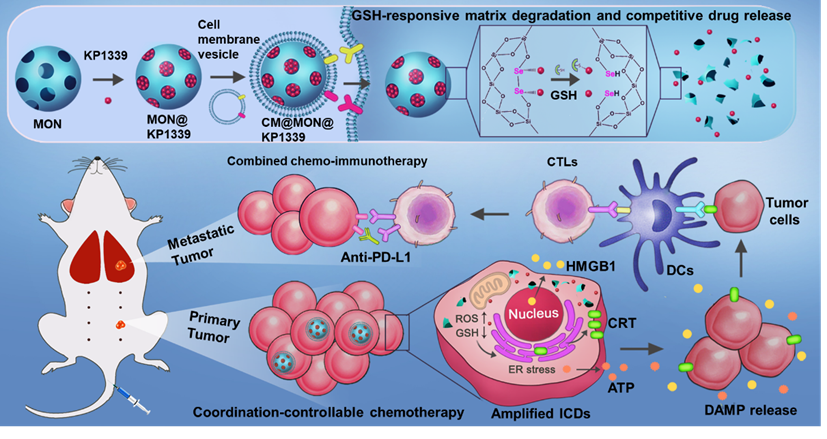Cancer chemoimmunotherapy has enjoyed significant clinical progress in recent years. Immunogenic cell death (ICD) is a particular form of cell death induced by various cancer therapeutics which elicit innate and adaptive immune responses. Although chemoimmunotherapy benefits treatment for solid tumors and inhibition of distant metastases, several studies have reported that anti-cancer drugs alone fail to promote sufficient ICD or elicit strong antitumor immunological responses. Further amplifying the chemotherapy-driven ICD in a natural or/and artificial manner is urgently warranted. Amplification of chemotherapy-driven ICD has been achieved through nanoparticulate carriers with tumor targeting and controlled-drug release capable of responding to external or internal stimuli.
Mesoporous organosilica nanoparticles (MONs) are excellent candidates for clinical application because of their tunable structure/chemistry and large surface area with controllable matrix degradation and responsive drug release. One of the scientific research subjects to be solved in cancer therapy is designing intelligent MONs that can be degraded and conduct controlled drug release in response to the tumor microenvironment characteristics, such as acidity, hypoxia, and high redox.
Recently, the research team led by Professor DONG Wenfei from the Suzhou Institute of Biomedical Engineering and Technology (SIBET), in collaboration with Professor SHAO Dan from the South China University of Technology and Professor SUN Wen from the Dalian University of Technology, developed a coordination-responsive diselenide-bridged MON loaded with the ruthenium compound (KP1339) for breast cancer chemoimmunotherapy.
KP1339-loaded MONs exhibited the glutathione (GSH) -stimulated coordination and redox dual-responsive drug release profile while induced intracellular GSH depletion and ROS production in breast cancer cells. Notably, a high concentration of diselenide-bridged MON specifically evoked oxidative and ER stress to induce and amplify ICD. The cancer cell membrane coating strategy promoted the MON@KP1339-amplified ICD. It boosted robust antitumor immunity, which further demonstrated better regression of both primary and distant tumors, as well as metastasis inhibition in combination with a PD-L1 immune checkpoint inhibitor.
This study suggests the design of biomimetic diselenide-bridged MON-based potential ICD nanoamplifier with a possibility of coordination and redox dual-responsive drug release and amplified ICD for efficient and safe cancer chemoimmunotherapy.
The research article "Coordination and Redox Dual-Responsive Mesoporous Organosilica Nanoparticles Amplify Immunogenic Cell Death for Cancer Chemoimmunotherapy" has been published in Small.

Figure 1. Schematic of synthesis of diselenide-bridged MONs for coordination-responsive drug release and amplified ICD for efficient and safe cancer chemoimmunotherapy.(Image by SIBET)
Contact
XIAO Xintong
Suzhou Institute of Biomedical Engineering and Technology, Chinese Academy of Sciences (http://www.sibet.cas.cn/)
Phone: 86-512-69588013
E-mail: xiaoxt@sibet.ac.cn